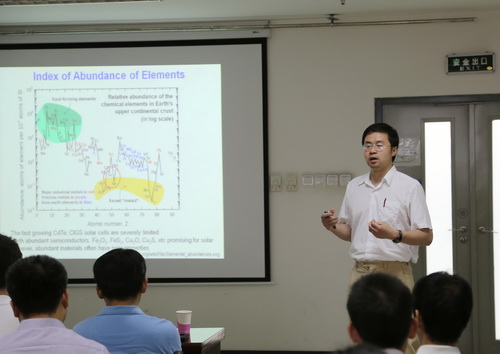
Invited by Key Laboratory of Photochemical Conversion and Optoelectronic Materials, Technical Institute of Physics and Chemistry, Chinese Academy of Sciences (TIPCCAS), Dr. Song Jin from University of Wisconsin-Madison visited TIPC on June, 25 and gave an academic report entitled Solar Energy Conversion Using Earth-Abundant Semiconductor Nanomaterials.
The scale of renewable energy challenge not only calls for highly efficient technologies but also abundant, inexpensive, and robust materials. Nanomaterials such as one-dimensional (1D) nanowires can help to mitigate the poor properties of earth-abundant semiconductors to enhance solar energy conversion.In the report, Dr. Song Jin first discussed a new growth mechanism of nanowires and nanomaterials, in which screw dislocation defects provide the self-perpetuating steps to enable anisotropic crystal growth. Building on this discovery and their understanding of the crystal growth theory, they have developed rational solution or vapor phase synthesis of nanomaterials of earth-abundant semiconductors, such as hematite (Fe2O3), pyrite (FeS2) and layer chalcogenides, such as MoS2 and WSe2, and investigated their photoelectrochemical (PEC) and photovoltaic (PV) properties. To understand the origins of their low solar performance and overcome the challenges facing these materials, they investigated their fundamental semiconductor transport and surface properties. Doping and nanostructuring strategies using 3D hierarchical nanocomposites are further developed to overcome the conflicting requirements by light harvesting and carrier collection. We also discovered that metallic MoS2 nanostructures with a high density of exposed edges directly on conductive graphite substrates have dramatically enhanced catalytic hydrogen evolution reaction (HER) catalysis.
Song Jin is the Vilas associate professor of chemistry at the University of Wisconsin-Madison. He received his Ph.D. in 2002 from Cornell University under the direction of Prof. Francis J. DiSalvo and carried out his postdoctoral research under the direction of Prof. Charles M. Lieber at Harvard University. Dr. Jin is interested in the chemistry and physics of nanoscale materials and solid state materials and their applications, especially in renewable energy. Dr. Jin developed innovative synthesis of a variety of nanomaterials including metal silicides, oxides and chalcogenides, and developed fundamental understanding of screw dislocation-driven growth of nanomaterials in the context of crystal growth theory. Building on the understanding of novel physical properties, Jin advances the interdisciplinary exploitation of (nano)materials for photovoltaic and photoelectrochemical solar energy conversion, thermoelectric energy conversion, energy storage, nanospintronics, and biotechnology. The unifying theme of Jin’s energy research is the focus on earth-abundant materials. Dr. Jin has authored or co-authored 4 patents and 84 publications. He has been recognized with a NSF CAREER Award, a Research Corporation Cottrell Scholar Award and as one of world’s top 35 innovators under the age of 35 (TR35 Award) by the MIT Technology Review Magazine, the ACS ExxonMobil Solid State Chemistry Fellowship, and the Alfred P. Sloan Research Fellowship. Most recently he received the Research Corporation SciaLog Award for Solar Energy Conversion and U. of Wisconsin-Madison Vilas Associate award and Romnes Faculty Fellowship.
NEWS